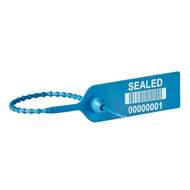The Critical Role Security Seals Play in Medical Safety
Posted by Steve Diebold
In general, tamper evident security seals serve one of two key functions -- or both, depending on the application.
On one hand they provide evidence of tampering or exposure, hence the “tamper-evident” label. The seal provides a clear indication if something has been opened, giving a high level of assurance that a critical item has not been touched by an unauthorized party if the seal is still intact.
The second role is identifying or verifying specific items through unique seal types, shapes, colors, markings, numbers, and coding. That way, a simple visual check can indicate what’s inside a sealed location without having to open it.
Both of these roles are critical in the medical field. Here are some specific uses that show the important function security seals play in medical applications.
- Product packaging and transit. Tamper evident
security seals are used to secure most medical supplies in their original
containers during transit. Items like drugs, needles, masks, test kits, PPE, medical
devices, and more need to be protected from theft and tampering. Security seals
will detect or deter contamination, spoilage, adulteration, theft, and
mishandling. The most critical substances sealed in this application are
narcotics, controlled substances, testing supplies, and medical devices that
are being transported to and from hospitals, labs, and pharmacies.
- In this application, it’s common to use tamper evident tape or a plastic tote with plastic pull-up seals. Many specialty medical products have customized security packaging with tamper evident closures built in. Other wholesale or bulk medical items are sealed in a large drum with a secondary seal on the inside plastic liner of the drum for maximum integrity.
- Receiving, storage, and distribution. It’s especially important in the medical field that incoming goods get recorded, sent to the proper place for use, and tracked. This is important for maintaining supply and scheduling replacements of critical items. Keeping record of the time and place of use, storage location, maintenance schedules, and more is also essential for safety purposes.
- Hospital supplies and samples. Plastic padlock seals
are often used for carts and storage bins in hospitals in situations where
opening and closing needs to be tracked. Rather than a traditional lock and key
in this scenario, a plastic padlock seal provides more visibility into who is
opening it, when, and why.
- Test samples also need to be sealed and labeled to maintain their integrity and ensure they are tied to the correct person or procedure. However, since they often involve pouches, tubes, and vials, mechanical seals are not practical here. Instead, they’re sealed with adhesive tapes or labels at the opening, then sealed in a plastic box or tote with an additional seal.
- Disposal of medical waste. Medical waste needs to be carefully stored and disposed of to avoid hazards and comply with regulations. Some of the regulations involve the use of security seals. For example, smaller items can be placed in bags or containers and sealed with a plastic pull-up seal marked with hazard symbols. These seals also help in tracking the quantity and location of medical waste collection and disposal.
These are just a few examples of how seals are applied in the medical industry, there are countless others. If you have questions about additional applications in this or any industry, reach out to one of AC&M’s experts who have decades of experience and are ready to help.

